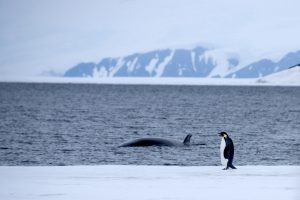
From DC to Antarctica: Gina Selig
Check out this new video from 2023 fellow Gina Selig discussing her work with the Antarctic Treaties Commission and her upcoming trip to Antarctica.
Scroll down to view posts

Check out this new video from 2023 fellow Gina Selig discussing her work with the Antarctic Treaties Commission and her upcoming trip to Antarctica.
In this episode of On My Coast, we’re joined by Beth Lenz (Assistant Director for Diversity and Community Engagement at Hawaii Sea Grant), Keith Ellenbogen (Associate Professor of Photography at SUNY the Fashion Institute of Technology & Visiting Artist at MIT Sea Grant), and Syma Ebbin (Research Coordinator at Connecticut Sea Grant & Associate Professor in Residence at the University of Connecticut) for a roundtable-style conversation about art and science. Portions of this live conversation have been edited for clarity.
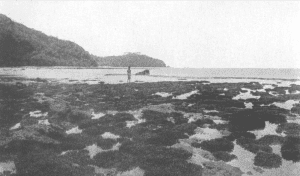
The Aua transect on Tutuila island in the remote island territory of American Samoa recently celebrated its 100th anniversary, and scientists from throughout the region traveled to the island to celebrate and conduct the 100th year transect survey.
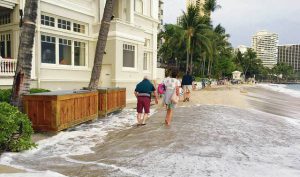
The highest mean water levels ever recorded in Hawai'i occurred in April 2017. Scientists with the University of Hawaii and Sea Grant predict there is more to come and provide early notice to help communities prepare.
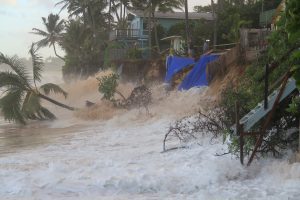
Hawaii Sea Grant’s work featured in U.S. Climate Resilience Toolkit
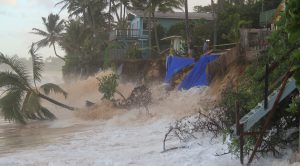
Hawai'i Sea Grant helps homeowners adapt and respond to coastal impacts.
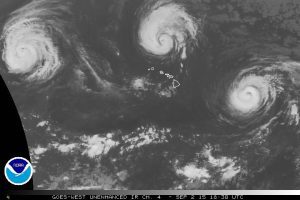
In response to a record-breaking Pacific hurricane season, Hawai'i Sea Grant led a NOAA Coastal Storms Program project to assess the risk of urban Honolulu to coastal inundation.
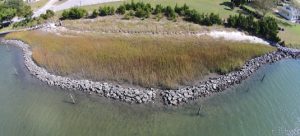
In the spirit of the collaborative nature of NOAA's Sentinal Site Program, Sea Grant provides coordinators to foster relationships among the various partners studying sea level rise and addressing community resilience.
Describes Hawai‘i’s water resources, identifies troubling trends (i.e., declining rainfall, reduced stream flow, increasing temperature, and rising sea level), and provides 12 potential adaptive tools for adaptive management of those water resources.
This report provides a basic summary of the observed and projected changes to Hawai‘i’s ecosystems and their resulting impacts for the state’s residents.
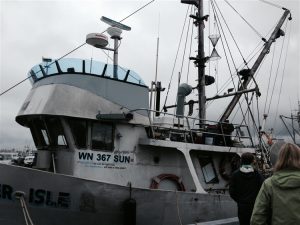
Sea Grant works with coastal communities to ensure that boaters on the water for fun and for work are knowledgeable and out of harm's way.
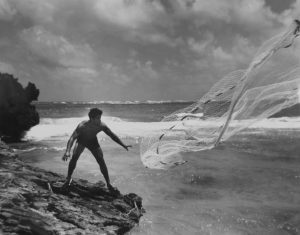
The University of Hawai‘i Sea Grant College Program took the initiative over 10 years ago to form a partnership with the Hawai‘inuiÄkea School of Hawaiian Knowledge and Awaiaulu to help make Hawaiian language newspapers articles from the 1800’s and early 1900’s accessible to the general public.
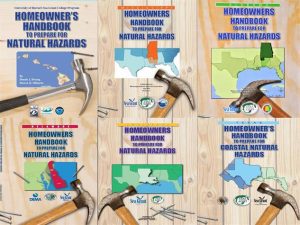
In 2007 Dennis Hwang and Darren K. Okimoto of the University of Hawai'i Sea Grant co-authored a community specific Homeowner's Handbook to Prepare for Natural Hazards. The handbook targets the average homeowner and essentially does as much homework for the homeowner as possible in order for a homeowner to prepare for natural disasters. Since 2007, the Hawai'i Homeowners Handbook to Prepare for Natural Hazards has gone through 8 print runs with over 65,000 copies. The handbook has been adapted by 7 other Sea Grant programs.
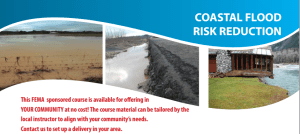
Washington Sea Grant staff members are certified to teach the FEMA-certified Coastal Flood Risk Reduction Course. This performance level course is designed to provide an introduction to flood-risk reduction opportunities within coastal communities.
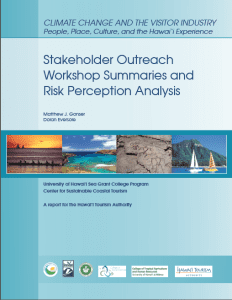
Details stakeholder outreach activities for the Climate Change and the Visitor Industry project, summarizing the state of knowledge of current and potential impacts of climate change on Hawai‘i’s tourism industry and coastal communities; identifying opportunities for adaptation and sustainability of the tourism industry; informing Hawai‘i’s decision-makers in the public and private sector of the potential impacts of climate change, and; providing an opportunity for the visitor industry stakeholders to provide feedback on the findings and assist in the identification of priority sectors for adaptation.
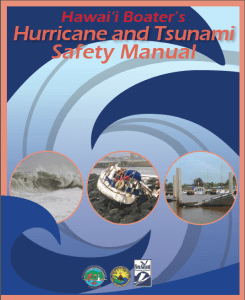
Provides a summary of the actions boaters and other members of Hawai‘i’s maritime community can take before, during, and after a hurricane or tsunami, to prepare for and mitigate the effects of these hazards.
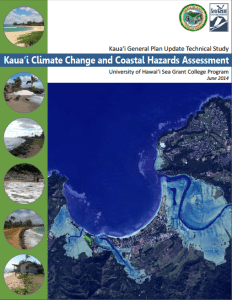
As a technical report for the Kaua‘i County General Plan update, the KC3HA looks to improve the community’s resilience and preparedness to coastal hazards and changing climate through the better understanding and utilization of coastal hazard information and planning tools. The report compiles and summarizes available science-based coastal and climate hazard information to assist in information the General Plan update.

Helps homeowners prepare for a natural hazard so that risks to family and property may be reduced. The handbook focuses on tsunami, hurricane, earthquake, and flood hazards.
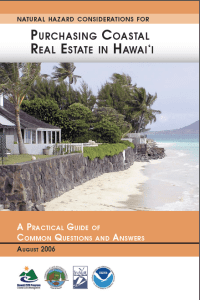
This guide focuses on basic question to consider as an investor in coastal real estate, emphasizing the importance of having an understanding of the potential risks and consequences of living on the ocean’s edge.
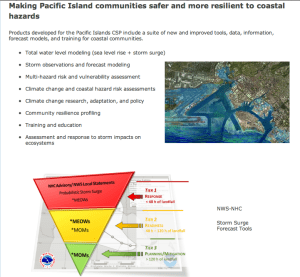
This nationwide effort implemented in the Pacific Islands Region funded several projects that foster community resiliency through outreach, education, and product development.
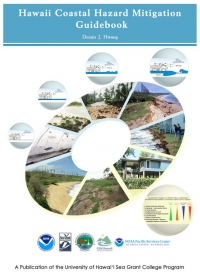
The purpose of the 242 page guidebook is as a resource to reduce the risk to coastal development by planning for natural hazards such as erosion, flooding, tsunami, and hurricanes. The guidebook uses scientific and technically-based standards for hazard mitigation and provides recommendations for implementation (e.g., guidance, industry standards, policy and the use of existing regulations) that minimize burden to the regulated community.
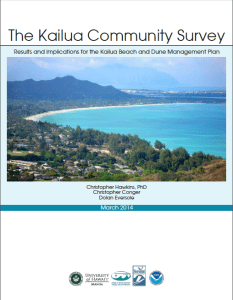
A report on resident’s attitudes, perceptions, preferences, and values towards a variety of socio-environmental topics. The study is part of a regional beach management and climate change adaptation planning efforts, and informs implementation and future modification of the 2010 Kailua Beach and Dune Management Plan.
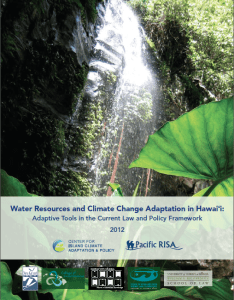
Describes Hawai‘i’s water resources, identifies troubling trends (i.e., declining rainfall, reduced stream flow, increasing temperature, and rising sea level), and provides12 potential adaptive tools for adaptive management of those water resources.
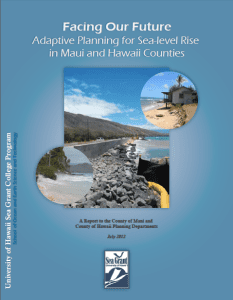
Five recommendations are presented to provide a foundation for improving shoreline planning for coastal hazards, including seal level rise, at the local level.
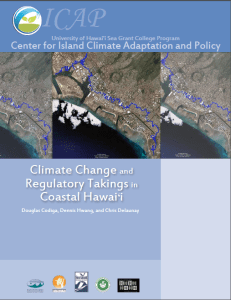
In light of projected sea level rise and adaptation responses (i.e., accommodate, protect, and retreat), this paper examines the interactions among climate change, the regulation of shoreline development in Hawai‘i, and Constitutional law regarding unpermitted takings of private property for public benefit.
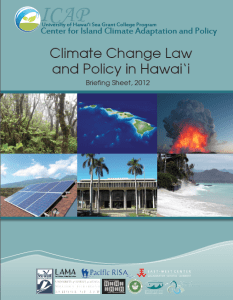
This briefing sheet provides a timeline of and descriptions for legislative actions related to climate change mitigation and adaptation in Hawai‘i.
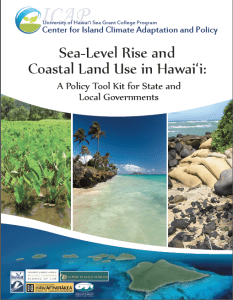
The purpose of this Tool Kit is to identify and explain key land use policy tools for state and local government agencies and officials to facilitate leadership and action in support of sea-level rise adaptation in Hawai‘i.
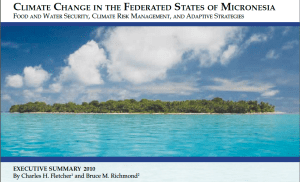
This study is an outgrowth of concern over the vulnerability of the Federated States of Micronesia (FSM) to sea-level rise and drought associated with climate change. The purpose is to identify climate risk and options in the FSM.
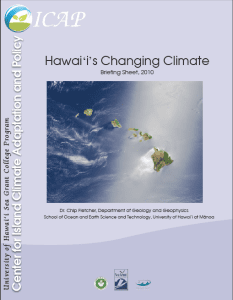
How is global warming influencing the climate in Hawai‘i? The purpose of this briefing sheet is to describe what is known in answer to this question as published in peer-reviewed scientific journals and in government reports and websites.
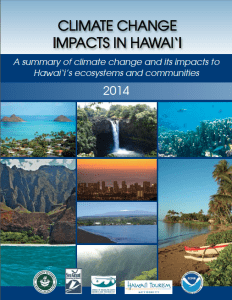
This report provides a basic summary of the observed and projected changes to Hawai‘i’s ecosystems and their resulting impacts for the state’s residents. The report focuses on five (5) systems: (1) marine ecosystems – (a) open ocean and (b) coral reefs and other nearshore habitats; (2) coasts and the built environment; (3) terrestrial ecosystems; (4) freshwater resources; and, (5) human health.
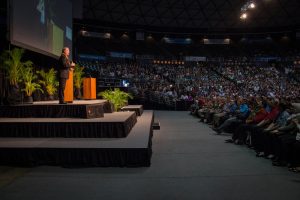
Former Vice President Al Gore gave a rousing seminar to discuss climate change science and sustainability at University of Hawaii Sea Grant.

Dennis Hwang combines his science and law background to concentrate on implementing science into decisions of the community so that hurricane, tsunami, flood, erosion, wind and earthquake impacts are mitigated. He authored the Hawai'i Coastal Hazard Mitigation Guidebook, which is used in the land use process in Hawai'i.
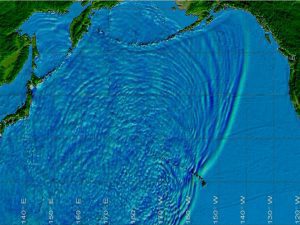
Dr. Kwok Fai Cheung's area of expertise is ocean wave modeling, which includes tsunamis. Sea Grant funded his research work on tsunami model development. His team worked with UNESCO to distribute the resulting model and provide training workshops to universities and government agencies around the world.
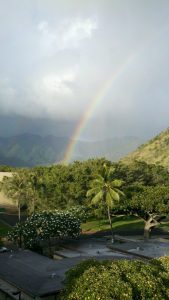
The Pauley Seminar is Capstone of Ascent: Energy and Water Sustainability, Presented by: University of Hawai‘i at MÄnoa Chancellor Tom Apple, U.S. Senator Brian Schatz, and the University of Hawai‘i Sea Grant College Program April 15
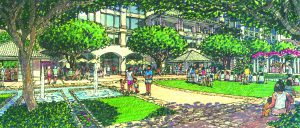
University of Hawaii Sea Grant College Program convened a nationally recognized team of experts to create viable, long-term solutions that elevate the quality of life within the existing and developing communities in 'Ewa, Hawai'i.

Dennis Hwang, Coastal Hazard Mitigation Specialist at University of Hawai’i Sea Grant developed the Hawai’i Coastal Hazard Mitigation Guidebook to address the lack of widely publicized, reliable guidance for building along the coast to reduce vulnerability. Due to the wide spread popularity, 7 states across the country developed similar books specific to their community.
UH Sea Grant was selected to receive the 2013 Dr. Chiu Award for Excellence in Hurricane Preparedness for its efforts to make Hawai‘i’s communities safer through its excellent work on the Homeowner’s Handbook to Prepare for Natural Hazards.
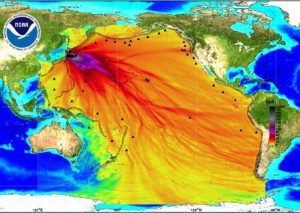
Tsunamis have been a reality for coastal communities for as long as humans have lived near the shore…